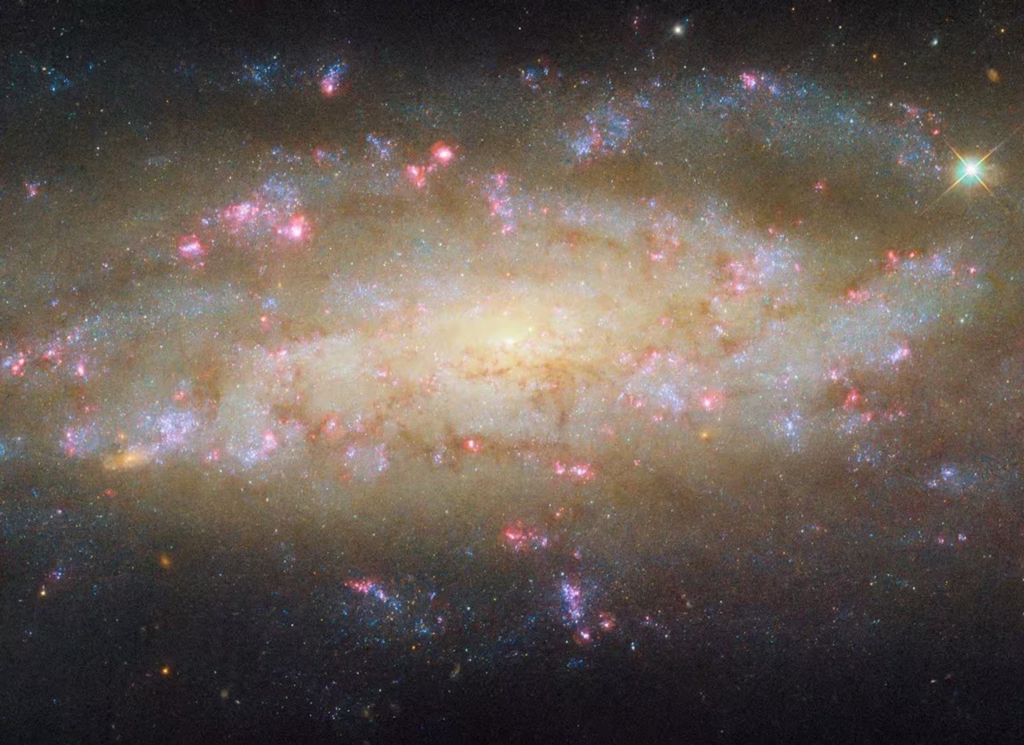Physical Address
304 North Cardinal St.
Dorchester Center, MA 02124
Physical Address
304 North Cardinal St.
Dorchester Center, MA 02124
Washington, D.C. – The NASA/ESA Hubble Space Telescope has captured a striking new image of NGC 7456, a spiral galaxy located more than 51 million light-years away in the constellation Grus, also known as the Crane. While it may look like just another spiral galaxy, astronomers say it holds a wealth of fascinating features worth studying in greater detail. The discovery has generated excitement among scientists because the galaxy combines several cosmic phenomena in one place, making it an exceptional object of study.

The newly released image highlights the galaxy’s spiral arms, which are streaked with dark dust lanes and dotted with glowing pink patches. These pink regions are dense with gas and serve as stellar nurseries where new stars are actively forming. As these young stars ignite, they heat up and illuminate the surrounding hydrogen clouds, creating the characteristic reddish glow seen in many galaxies. The patchy structure of the arms, with their mixture of dust and bright star-forming regions, offers astronomers valuable insight into how galaxies sustain and regulate star birth over time.
Astronomers emphasize that these glowing regions are not just pretty details. They act as markers of active galactic evolution. By analyzing them, researchers can measure the rate of star formation, identify how long clusters survive, and determine how gas is recycled within the galaxy.
This galaxy is an astronomer's delight.
— NASA (@NASA) September 5, 2025
Newly-forming stars, a supermassive black hole, and incredibly powerful X-rays can all be found within NGC 7456, seen here by @NASAHubble: https://t.co/6Qe3sGl8oQ pic.twitter.com/B9j8t1shb3
NASA explained that the observing program behind these images was specifically designed to study stellar activity in galaxies like NGC 7456. The data collection included monitoring clusters of new stars, mapping clouds of hydrogen gas, and analyzing how stellar winds interact with surrounding material. Such investigations are key to understanding how galaxies like this one evolve from youth to maturity.
The study of NGC 7456 also provides opportunities to compare its activity with other spiral galaxies in the nearby universe. By looking at similarities and differences, scientists can piece together how galactic environments shape star birth and how external factors, such as interactions with nearby galaxies, might influence its structure and growth.
Hubble, which excels in capturing visible, ultraviolet, and some infrared light, is not alone in observing NGC 7456. ESA’s XMM-Newton satellite has repeatedly observed the galaxy in X-ray wavelengths. These studies revealed several ultraluminous X-ray sources, compact objects that shine with astonishing brightness. Despite being relatively small in size, they emit far more energy than standard stellar remnants like neutron stars or black holes usually do.
The exact cause of these ultraluminous X-ray sources remains a puzzle. Some scientists suggest they may be black holes devouring material at extreme rates, while others propose they might involve exotic processes not yet fully understood. Each new detection adds another piece to this cosmic mystery and keeps astronomers returning to NGC 7456 for more observations.
Beyond its star-forming regions and unusual X-ray sources, the galaxy is home to a supermassive black hole at its center. The surroundings of this black hole glow with extraordinary intensity, releasing energy that makes the galaxy stand out as an active galaxy. The activity near the central black hole dominates much of the galaxy’s energy output, producing bright emissions across multiple wavelengths. This makes NGC 7456 not only a source of interest for stellar studies but also for research into the behavior of supermassive black holes and the role they play in shaping galaxies.
Astronomers point out that active galaxies like NGC 7456 are particularly useful for exploring the connection between black holes and galaxy growth. The intense radiation and energetic outflows from the black hole’s environment may regulate or even suppress star formation in certain areas, demonstrating the delicate balance between stellar birth and the gravitational pull of a central black hole.
From glowing nurseries of newborn stars to compact objects producing powerful X-rays, and from dusty spiral arms to an energetic supermassive black hole, NGC 7456 offers astronomers a rare combination of features that make it an ideal laboratory in space. Scientists continue to examine its structure across multiple wavelengths, combining data from Hubble, XMM-Newton, and other observatories to gain a clearer picture of how galaxies evolve.
The study of NGC 7456 underlines how much more there is to learn about our universe. Even galaxies that seem ordinary at first glance can surprise astronomers with their complexity and richness when viewed through advanced telescopes. Each observation deepens our understanding of the cosmos and highlights the powerful tools scientists have to explore the distant reaches of space.
Reference : Hubble Spies Galaxy with Lots to See